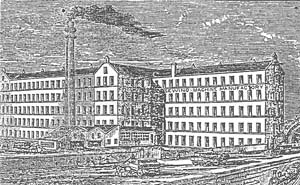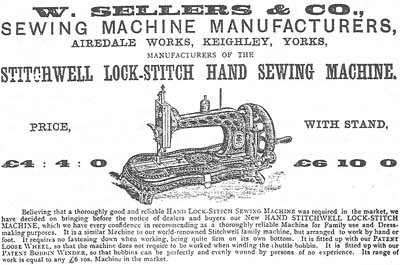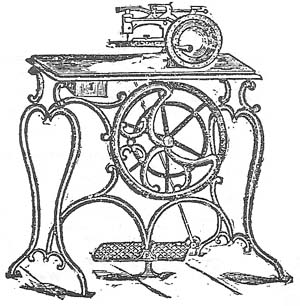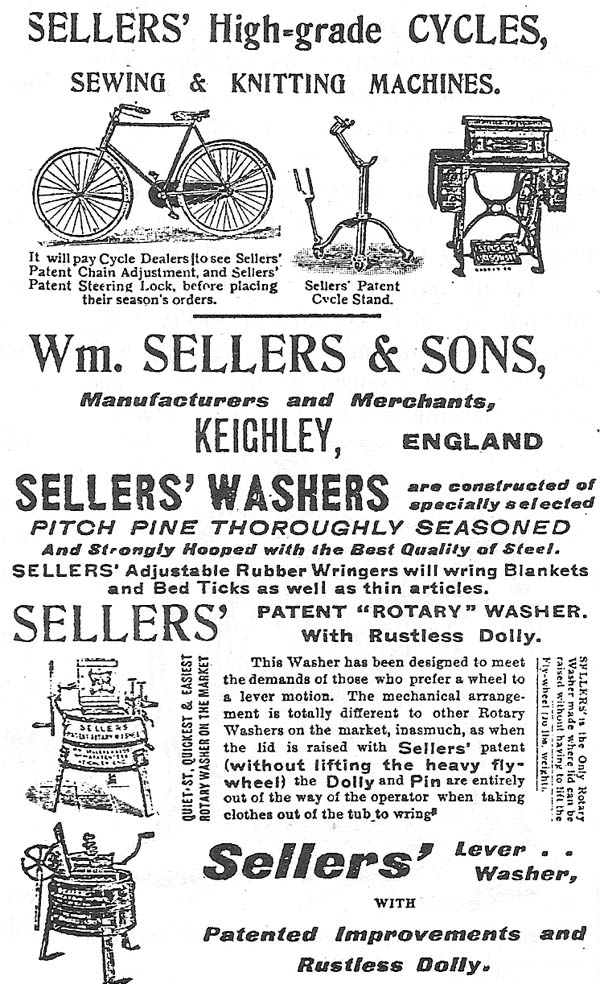William Sellers' History
ISMACS News
Issue 26
January 1990

The Airedale works in all its glory. From an engraving done in 1880.
WILLIAM SELLERS was born about 1834 and after schooling, signed papers as a apprentice for an engineering company in Birmingham.
After a couple of years an industrial dispute broke out with the workers at first going on strike and then being locked out -- a popular anti-union move by managements at the time.
The lock-out favoured the young Sellers for it meant in law that his employees had abandoned his contract and he was able to leave without penalty.
He spent the next four years doing various handyman jobs in the Rossendale and Keighley areas before doing a deal with his brother that was to set him on the path to becoming Yorkshire's largest sewing-machine manufacturer.

Seller's famous Stitchwell was available on this iron base or let into a wooden baseboard.
William's brother -- whose name is not known -- ran a lathe-manufacturing company with a partner called Darling in Lawkholmland, Keighley.
In 1854 William Sellers persuaded his brother and the partner to allow him to set up a small machine room in the attic of their business, and here he set to making the new-fangled sewing machines.
Like many other British pioneers of the time, Sellers did not seem to give much original thought to his designs and concentrated on making copies of the Thomas machines and of the Lancashire (itself a copy of the American Grover & Baker).
He turned them out one at a time and, having finished a model, would put it on his back and set out to sell it to a local tailor.
Copycat design or not, obviously the quality of manufacturer was good enough, for soon the orders started to flood in. It was then that Sellers realised the true worth of his factory site on the railway line and on the banks of the River Aire, ensuring ease of supply for materials and for sending out the completed machines.

The ultimate rip-off. Sellers' Singer-style advertising.
By the late 1860s the company was showing at major exhibitions with the best result of a gold medal at the International Show in Amsterdam in 1869.
Obviously flushed with this success, Sellers set out a year later on an advertising campaign which included the biggest piece of plagiarism in the whole of the early industry.
Taking advantage of having the same initial as Singer, he copied that illustrious firm's trade mark and advertising copy with only the name changed. In his eyes -- and anyone glancing at a machine or an advert -- the Big Red S was Sellers.
It worked. By the mid 1870s production was at its height with up to 300 machines a week rolling off the Airedale Works assembly lines.
As well as sewing machines the company made peggy tubs and sticks -- a sort of do-it-yourself washing machine -- rolling pins, stools, bath cabinets, kilt-making machines and even a coin-operated chocolate dispenser.

This early industrial from the Sellers stable obviously owes much to the Thomas design.
For the wholesale trade and for export, a separate company was set up with an accountant, George Allen, with offices in London in 1877, and the joint names Sellers and Allen appear on the "hand"-decorated machine owned by ISMACS member Diana Herbert.
This model was in production over only one year.
Later the firm of William Sellers and Sons went into cycle production and even had a stab at making a motor car in the early years of this century.
Despite attempts by the local library historians, the Peter Black company who now use the original factory and by myself, we have yet to come up with an exact date that the firm folded.
Apart from the "hand" machine featured on the front cover of ISMACS News 18, there is little to commend the Sellers machines to collectors.
The main range consisted of a Singer look-alike called the Stitchwell and another machine, called the Seamstress, which is yet another Jones clone, even using the same decoration as the Audenshaw-built machines.
The Stitchwell was available on an iron base as well as let into a wooden base as in the Singer Family.
There is still obviously a lot of work to be done in researching the Sellers company and hopefully it can be a little more detailed than that carried out by a local museum curator just after the war.

Sellers' advertisement in the Ironmonger in 1884.
Taking his historian duties seriously our curator, Maurice Longbottom, sought out William Sellers' only surviving son and interviewed him on life in Keighley in the "old days". What he didn't do was even jot down the Christian name of the 90-year-old man he was questioning. So much for posterity.
At the time of the interview there was at least one Sellers machine in the Keighley Museum.
This was said to be a Thomas-type machine. It was given to the museum by one Mr. West Parker of Haworth, a former employee of the Sellers company. It had been used for shirt and dress making in the Parker family from 1874 until the early 1920s.
GF

Sellers advertisements showing the diversity of the Yorkshire company's products.





